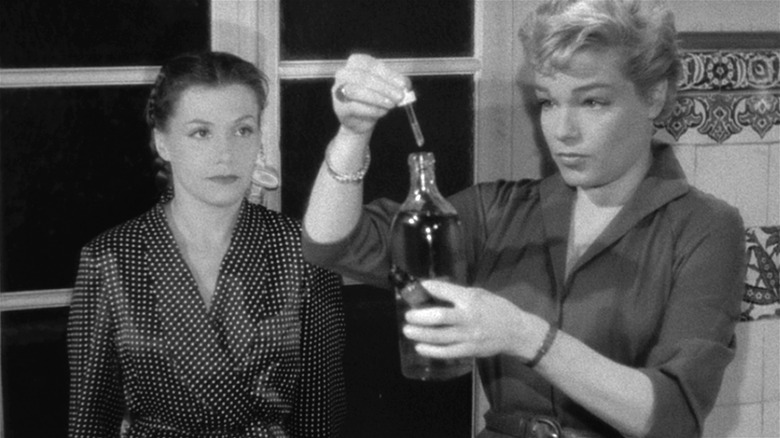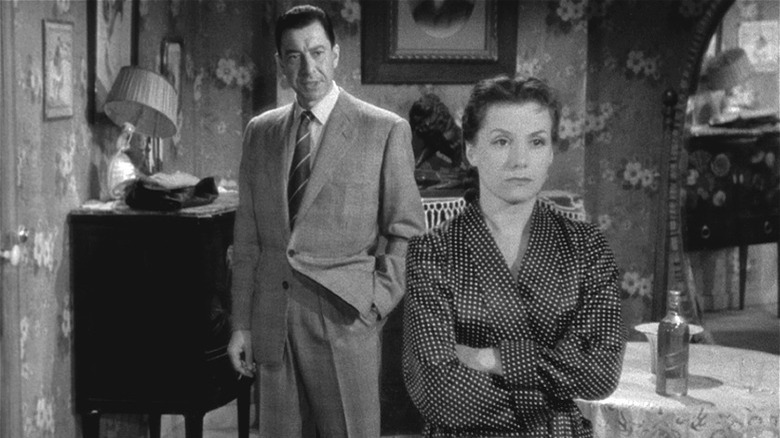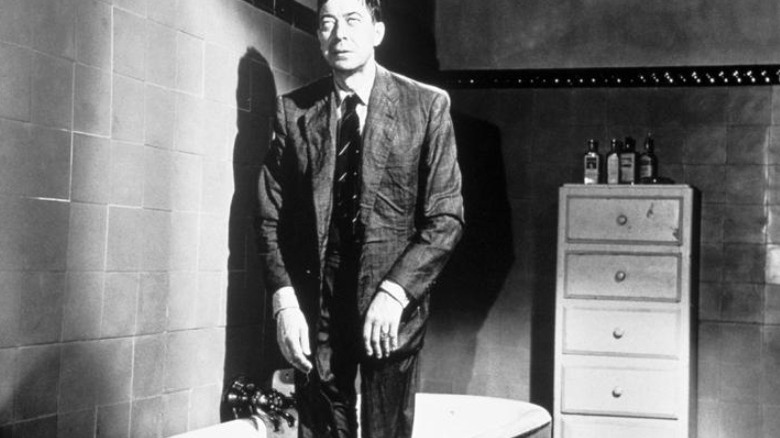Henri-Georges Clouzot Had A Simple Goal When It Came To Creating Diabolique
Layered psychological horror-thrillers that evade cliché tropes can be hard to come by. Classic thrillers such as "Psycho" and "Repulsion" come to mind, as these films managed to unsettle audiences with their unconventional twists and evocative visual language. However, the psychological thriller genre owes a massive debt to Henri‑Georges Clouzot, whose 1955 thriller, "Diabolique," etched a benchmark like no other. Unraveling like a maze with several dead-ends and false exits, the central mystery in "Diabolique" is exquisite to behold to this day. In fact, the film's legacy is so undeniable that several filmmakers, including Alfred Hitchcock, were inspired by Clouzot's work. "Diabolique" is a chilling murder-suspense tale that is still replicated in loose adaptations and contemporary remakes.
From the get-go, "Diabolique" sets up Michel (Paul Meurisse) as a monstrous figure whose cruelty knows no end. He's emotionally abusive toward the boys at his boarding school and treats his wife Christine (Vera Clouzot) with great disdain. When his mistress Nicole (who happens to be a teacher) is introduced, expectations are subverted when Nicole and Christine bond over their mutual hatred for Michel. A revenge murder plan is hatched, which ends in a string of disturbing developments that leave both women spooked. "Diabolique" builds up its suspense and twists with the aid of atmospheric terror, often relying on expertly-crafted red herrings and vague suggestions of something diabolical. These elements add greater effect to the film's ultimate twist, which still manages to leave first-time viewers gobsmacked.
This begs the question: what did Clouzot have in mind while making "Diabolique"?
A game of cruel intrigues
An essay on "Diabolique" by The Criterion Collection states that Clouzot's primary intention behind crafting the film was to "amuse" himself in the same way when parents tell a frightening bedtime story to their child. "I just produced it as I would a game," Clouzot said, which informs the caustic trope inversions he employs in the film to keep matters thrilling. Clouzot constructed "Diabolique" as a story about a near-perfect murder that disintegrates into a dangerous game of backstabbing and covert intentions. This is no children's tale, as the world of "Diabolique" is chilling and ruthless, where people wear masks with startling conviction and indulge in extremes to satiate their psycho-sexual impulses.
Clouzot has often been described as the "French Hitchcock," which, for all intents and purposes, is an unfair label. Clouzot and Hitchcock certainly share similarities, especially in the way they wield sound/sight as weapons to twist the narrative knife deeper. However, Clouzot's masterwork clearly served as inspiration for Hitchcock, and not the other way around, as the "Psycho" director took some major cues from "Diabolique" while working on his own masterpiece, "Vertigo." Interestingly, Hitchcock's "Vertigo" was adapted from Pierre Boileau and Thomas Narcejac's "D'entre les morts," and the duo also happen to be the authors of the novel "Diabolique" is based on ("C'elle qui n'etait plus"). While these connections strengthen the inspirational overlaps between Clouzot and Hitchcock, the two remain distinct in their approach and execution, despite sharing a similar morbid vision.
Various sources claim that Hitchcock lost an option for "C'elle qui n'etait plus" to Clouzot, meaning that "Diabolique" could have been directed by Hitchcock in a different world. While Hitchcock is clearly adept at what he does, Clouzot had an extraordinary plan for "Diabolique," which matured into a game-changing cultural phenomenon.
Why Diabolique remains the blueprint for psychological thrillers
When analyzed on a straightforward narrative level, the central mystery and twist ending of "Diabolique" is neither too convoluted nor a stroke of genius. However, the core appeal of the film resides in its ability to sow certain emotions in the viewer, which pile over time and culminate why the time the credits roll. The quintessential "villain" of our story, Michel, has no redeeming qualities — he represents the moral decay in administrative structures and personal relationships that become normalized over time. Even after the women manage to kill him as a part of their plan, his specter seems to haunt the school and its grounds, a constant reminder of his tyrannical presence and the effect it has on those around him.
The narrative blueprint of Clouzot's classic film has been imitated and done to death, to the point that contemporary audiences will be able to spot the twist from a mile in a similarly structured film. However, Clouzot lays out convincing traps for its viewers in a way that makes for an exciting, visceral experience, where the characters act according to the conditioned impulses that dictate their respective arcs. Coupled with this, Clouzot uses recurring visual motifs to convey the nastiness of the world that the characters inhabit: the murky, stagnant swimming pool that assumes greater significance later on, rotten fish being served at the school cafeteria, and cold, sterile environments inhabited by even colder characters.
These elements come together to form a story with a rotting moral center, forming an impossible labyrinth in which Clouzot moves the pieces as per his cynical perception of humanity and the calculated cruelties we are capable of. Especially due to this unique brand of morbid pessimism, "Diabolique" remains untouchable.


